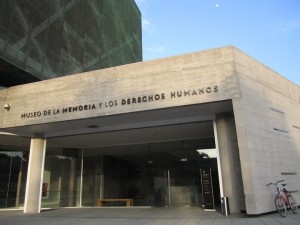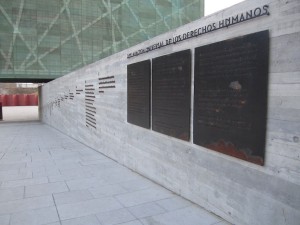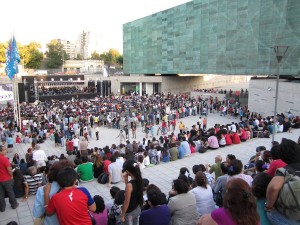The Museum of Memory and Human Rights: Making consensus matter?
23 May 2012 – Zachary McKiernan
Letters from Chile, advocacy, public engagement, memory, archives, museums, government, human rights, international, politics
 Since my September arrival in Chile, the Museum of Memory and Human Rights has become a common ground for my historical work, with handfuls of visits to its Center of Documentation for conversations and conferences, and the permanent exhibit. Although not a physical or recovered site connected to human rights violations, it sits squarely in the memory landscape of Chile, a barely-born institution that has made waves since its 2010 inauguration under then-President Michele Bachalet. The museum’s history has roots reaching back to the Rettig Commission’s recommendations (1991). Its creation weaves through the demands of human rights organizations and their UNESCO designated “Memory of the World” archives, and the commitment of two consecutive presidents of Chile’s Concertación, the center-left political bloc whose reputation for handling human rights reparations in the post-dictatorship period (1990-2010) is still questioned and critiqued. The museum’s executive director Ricardo Brodsky told me in an April 2012 interview that the museum represents a collaborative effort between diverse sectors of civil society and the state.
Since my September arrival in Chile, the Museum of Memory and Human Rights has become a common ground for my historical work, with handfuls of visits to its Center of Documentation for conversations and conferences, and the permanent exhibit. Although not a physical or recovered site connected to human rights violations, it sits squarely in the memory landscape of Chile, a barely-born institution that has made waves since its 2010 inauguration under then-President Michele Bachalet. The museum’s history has roots reaching back to the Rettig Commission’s recommendations (1991). Its creation weaves through the demands of human rights organizations and their UNESCO designated “Memory of the World” archives, and the commitment of two consecutive presidents of Chile’s Concertación, the center-left political bloc whose reputation for handling human rights reparations in the post-dictatorship period (1990-2010) is still questioned and critiqued. The museum’s executive director Ricardo Brodsky told me in an April 2012 interview that the museum represents a collaborative effort between diverse sectors of civil society and the state.
But for others in Chile, consensus—and therefore the museum—is a euphemism for complacency, an agreement to deflect the hard questions (Dónde Están?) and reflect on a future that tacitly forgets parts of its past. It signals the end of debate, the completion of critical work. Tomás Moulian writes in Chile actual: Anatomia de un mito (2002) that “consensus is the most advanced stage of forgetting” (translated and quoted in Michael Lazzara, ed., Chile in Transition: The Poetics And Politics of Memory, 2006, p. 17). Cultural critic Nelly Richard adds that during the Concertación governments of the 1990s, “Pluralism and consensus were the issues called on to interpret a new social multiplicity whose ebbs and flows of opinion should, supposedly, express the diverse, but whose diversity had to be regulated by certain pacts, understandings, and negotiations that would contain its excesses so as not to revive the collision of ideological forces that divided us in the past” (Cultural Residuals: Chile in Transition, trans. Alan West-Durán and Theodore Quester, 2004, p. 16). So yes, when the executive director of the celebrated Museum of Memory and Human Rights told me in a well-appointed office that the museum represented consensus, it gave me pause.
The museum’s fundamental objective–“to give visibility to the human rights violations by the Chilean State between 1973 and 1990; to dignify the victims and their families; and to stimulate reflection and the debate about the importance of respect and tolerance, so that these events are never repeated”–confines and defines the consensus politics of post-Pinochet Chile. Why, as some have discussed with me, does the museum only focus on the years between 1973 and 1990, binding time and space in a conversation which arguably deserves to explore the precedents before and processes after these years? Well known human rights activist Alicia Lira, president of the Agrupación de Familiares Ejecutidos-Politicos, tossed at me lightly the question of where in the museum’s story is the self-liberation, the base Christian groups, the clandestine meetings, the bello or beauty of the human rights movement during the dictatorship? I myself have questioned the museum’s aims and energies in a time when torturers still hold public office and receive comfortable retirement packages for service during the Pinochet years.
But the reality of the situation, at least in my eyes, is that the Museum of Memory and Human Rights is fulfilling a critical role in a critical transition in Chile, and will continue to do so. My visits, in their many forms, have demonstrated the power of this public place: elementary and middle-school students scribbling notes in notebooks, presenters such as the historian Steve Stern and Fernando Botero’s art exhibit of Abu Ghraib, the middle-aged Chilean visitor on a guided tour sharing her experience of “olla communes” (community pots) in the 70s and 80s, engaged international backpackers asking questions, graduate students in the archives, archivists digitizing documents, and so much more. Call it a consensus, but this, I believe, is what is special at the museum: an open-ended encounter that cuts across language and cultures, disciplines and principals, politics and people.
If the museum is hampered by its intent to harness a particular vision of history so too has it unleashed creative energies that press against new and old boundaries. This might take the form of personal reflections or memory debates, but it may also manifest in other areas such as human rights education, historical interpretation, and museum administration—areas in which the museum seemingly excels. Brodsky emphasized the dynamic nature of the institution, its ability to adapt to present needs, the aim to “universalize our message of human rights.” Cherstin M. Lyon’s sharp review of the Museum of Memory and Human Rights notes that it “is designed not just to preserve the memory of a historical narrative. It is also meant to be an educational tool that will remain relevant to new generations that encounter human-rights challenges in new contexts” (The Public Historian, Vol. 33, No. 2, May 2011, p. 141).
Lyon’s very next line, though, drawing on Edward Linenthal’s analysis of the National Holocaust Museum in Washington, D.C., is relevant: “As powerful and moving as the museum is, it cannot replicate the raw emotion of informal memorials, historic sites, and cemeteries.” True. To a degree. That the museum isn’t physically connected to a public place were human rights violations occurred may detract from raw emotion. But it shouldn’t detract from the fact that the museum is an historic place. If we remove history from its museumified past and into a dynamic present, then we may see the museum in Santiago de Chile as an historic site right now—in the social-historic process of the present—marking and making a society a generation after it was split in two in 1973. Whatever the case, whether you’re looking for raw emotion or the cooler side of consensus, I put the Museum of Memory and Human Rights on the top of my list for anybody exploring Chile’s recent past and its historic present.
~ Zachary McKiernan





